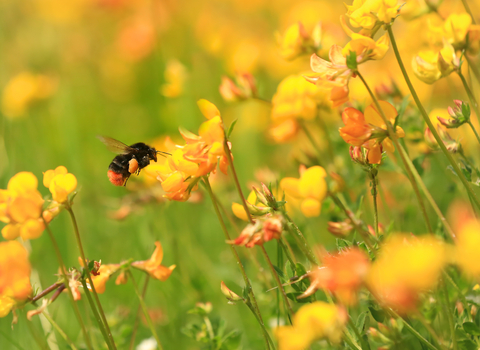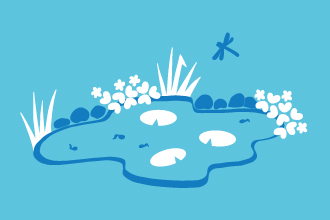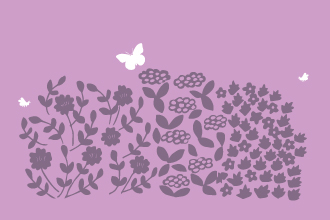Together, our gardens are a vast living landscape. With an estimated 24 million gardens in the UK, the way they are cared for can make a big difference to the natural world
Go wild in your garden! Large or small, ledge or yard, your garden can be a mosaic in a wider network of natural havens linking urban green spaces with nature reserves and the countryside.
Hedgehogs, bats, sparrows, song thrushes and stag beetles are all declining species in the UK, but if we manage our gardens to benefit wildlife, these creatures and many more will find refuge. It’s not hard to help. Consider a whole host of wild ideas and features – or just pick one and then sit back, enjoy the view and see who visits!
Why have a plain, ugly fence when a green, living boundary can bring the riches of flowers, scent, berries, rich autumn colours and wildlife? Ever thought about which heavenly-scented plants provide night-time nectar for moths? Or digging a pond? If you introduce a water feature, not for fish but for newts, dragonflies, and pond skaters, you'll also be providing water for birds. Plant up the edges with the golden blooms of marsh marigolds and the lush spikes of purple loosestrife and you'll have nectar stations for insects and beauty to dwell on.
Working together, people can change the natural world for the better. We can achieve a Wilder Future!

Red-tailed bumblebee ©Jon Hawkins - Surrey Hills Photography
Want to hear more from the Wildlife Trusts?
As a member, as well as supporting wildlife in your local area, you will receive a fantastic wildlife magazine.
Fresh, home-grown food - for you and your garden visitors!
We've come together with three other well-loved national organisations and, with funding from The National Lottery Heritage Fund, we've launched an initiative to inspire, support and encourage everyone to get growing food in a wildlife-friendly way - called Coronation Gardens for Food and Nature!
The National Federation of Women's Institutes, Garden Organic, Incredible Edible and The Wildlife Trusts are working alongside one another in communities up and down the country. Inspired by our #TeamWilder community organising work, we're listening to what communities want and helping everyone to make little (or large!) steps towards a Wilder Future.
Coronation Gardens for Food and Nature is for everyone, beginners and the more experienced alike. And you don't need a garden, either. From windowsills to community orchards, patios to allotments, we're making space all over the country.

Pledge your garden or growing space!
Coronation Gardens for Food and Nature is open to everyone. Add your space to our map and join our growing community!
More ways to help wildlife in your garden
Find more ways to take action for the wildlife in your garden by clicking on our guides below.
Download your wildlife gardening guide
Wildlife-friendly gardening is about making a haven for you, as well as for wildlife. By gardening sympathetically for wildlife, you’ll be rewarded by a truly natural outdoor space, where you can get in touch with the plants, animals and birds that make their home there.
Download your guide to creating a pond
Creating a pond is one of the best things you can do in the garden for wildlife. And it doesn't have to be big! Even mini container ponds can create essential habitat to garden wildlife.
Download your guide to helping butterflies
Butterflies and moths aren’t doing too well at the moment, with many species declining in recent years. But, the good news is that we can help through gardening!
Download your guide to helping worms
These wriggly fellows are well known to gardeners all over. At first glance they might not seem particularly special, but they’re essential for our soils and wildlife.
Download your guide to helping hedgehogs
Small, round, brown and famously covered in spines, the hedgehog is one of the most familiar of Britain's wild mammals.
Download your guide to helping bats
Bats are stars of the night, seen swooping through the night sky in the pursuit of their prey. Little understood, just what is the truth about these enigmatic mammals?
Download your guide to helping bees
It’s no secret that many pollinators are facing threats. Insensitive land use, a reduction in plant species diversity and the use of insecticides have all been linked to declining bee numbers. This is bad news for us and for them. But you can help...
Download your guide to helping high fliers
No stranger to a long-haul flight, swifts, swallows and martins travel all the way from Africa to spend each summer in the UK. There are lots of simple things that we can do at home to support these special birds.
Download your guide to boosting beetles
Beetles are brilliant. They recycle waste, pollinate plants and help keep aphids and other invertebrates in check. There are lots of simple steps we can take to invite more beetles into our gardens.
Download your guide to creating a wilder lawn
Our lawns are so much more than just a patch of grass. With a bit of care and attention – or even inattention – a lawn can provide a sanctuary for our natural neighbours. Take some time to get to know the plants and animals in your lawn, and you might be surprised at what you find!

















